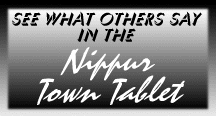

In this excerpt from Chapter XII Nejef and Kerbela, John Peters describes unpleasant features of the Mesopotamian environment.
[p. 310] Another night we were unpleasantly reminded of the proximity of the desert. After the universal custom of the country, we were sleeping on the roof, when a sand storm arose, nearly carrying our clothing into the river, and compelling us to take refuge in a little room with tight closed doors and windows, where we suffocated for some hours before it passed over. Owing to the heat of the climate, a night within doors in Iraq between April and November is almost unendurable. In July, 1889, the average daily maximum temperature at Baghdad was 114� in the shade, and in 1890 we encountered the same temperature more than once in June.
The kaimakam, who was a native of Trebizond, on the Black Sea, suffered sorely from this heat. He also complained bitterly of the insects, and the snakes, scorpions, and lizards which [p. 311] crawled over his walls and dropped down from his ceiling when he tried to take an afternoon siesta. I did not find the heat so trying, owing to the extreme dryness of the atmosphere and the constant wind. Serpents and scorpions occasioned me no trouble, and the fleas became a matter of indifference; but the flies were the most terrible pest I have ever been called upon to endure. The countless myriads of tickling, buzzing, biting things, from which there was no escape from dawn till dark, in house or field, in motion or at rest, irritated me to such an extent that I often seriously feared lest I should temporarily lose control of my senses and commit some act of wanton violence, or run amuck, like the Malays.
The common flies were the worst pests because of their permanence; the sand flies, which, in themselves considered, are far more terrible, were fortunately only temporary crises. These sand flies of the Euphrates are very small, fragile looking insects, apparently consisting of little more than wings and stings. As a protection against them only the very finest netting is of any value, and when they come in large numbers nothing seems to avail. They do not confine themselves to the exposed portions of the body, moreover, but find their way through or under all covering. Their bite is peculiarly venomous, and the irritation is accompanied with a sharp, burning sensation. They sometimes descend upon you for a night or two at a time in vast numbers, almost like a cloud.
I recall the attempt I made to dress myself on one such occasion. They had penetrated the sheets or under the sheets, tightly as I had fastened my bag bed at the mouth, and finally drove me out. There the main army was waiting to devour me, and the agony of those three minutes before I could cover myself was almost insupportable. The physical pain was so great, that it was only by the strongest effort of the will that I could control myself sufficiently to put my clothes on, which reason told me was the only safe [p. 312] course. I wanted to run and throw myself into the river. And yet I believe that I do not suffer from them as much as most people.
This excerpt is taken from John Punnett Peters, Nippur or Explorations and Adventures on the Euphrates: The Narrative of the University of Pennsylvania Expedition to Babylonia in the Years 1888-1890, New York: G.P. Putnam's Sons, 1897, Volume II, pp. 310-312.
Click on these links to navigate our site:


| Sign My Guestbook | View My Guestbook |